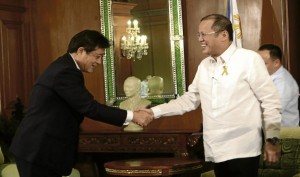
PRESIDENT Benigno S. Aquino III welcomes Mitsubishi Motors Corp. president Osamu Masuko during a courtesy call at the Music Room of Malacañang Palace. photo courtesy of Malacañang
We may already have the requisites: The Philippines is now exceeding forecasts—its 6.6-percent growth in 2012 makes it among Asia’s best performing economies.
Filipinos are now back in car-buying mood: for the first time since 1996—this is the year before the Asian financial crisis that dampened the spirit of Filipino auto buyers—auto sales went above the 162,000 unit mark. Vehicle sales in 2010 reached 168,490 units and 165,056 units in 2011, while last year’s figure set a new record of 185,059 units.
Auto manufacturing hub
Besides, like Thailand’s Chonburi and Rayong provinces (located east of Bangkok), the Philippines also has the province of Laguna where most automotive and parts assemblers and manufacturers are clustered together since the ’90s.
“We love what is happening in the Philippines but we are not yet considering it as our next alternative auto production hub. However, we will expand the capacity of Mitsubishi Motors
MITSUBISHI Fuso Truck and Bus Corp. SVP Kai-Uwe Seidenfuss (from left) with Mitsubishi Motors Philippines Corp. EVP, CFO and treasurer Kazuki Sugino; MMPC executive vice president Taizo Furuhashi; MMPC president and CEO Hikosaburo Shibata; Deputy House Speaker Lorenzo Tañada III; MMPC president Osamu Masuko; Vice President Jejomar C. Binay; former President Fidel V. Ramos; Sojitz Corp. president Yoji Sato; Asian Transmission Corp. president and CEO Mitsuka Kaneko; MMPC SVP for marketing and treasury Orlando F. Alvarez Jr. and MMPC SVP for manufacturing Masato Sada
Philippines Corp.’s manufacturing plant here in preparation for the several new vehicle models that we plan to produce in the next few years,” said Mitsubishi Motors Corp. (Japan) president Osamu Masuko during a morning meeting held at the Fairmont Makati.
Masuko, later in the evening, joined Vice President Jejomar Binay as well as top executives of local automotive firms in the Philippines in celebrating MMPC’s 50th anniversary as well as Asian Transmission Corp.’s (a wholly owned subsidiary of MMPC) 40th anniversary.
Dwarfed by demand
Masuko explained that while the Philippines’ annual automotive sale of over 180,000 is already impressive, this figure is dwarfed by the domestic vehicle demands of Thailand, which already reached 1.43 million units in 2012 or even Indonesia, which sold 1.12 million units last year.
In fact, while the 2012 automotive production in the Asean region rose 41.5 percent to 4,237,980 units from 2,994,629 in 2011, the Philippines accounted for a measly 1.78 percent of the region’s total output in 2012.
Both Thailand and Indonesia have entered a phase of full-fledged motorization as their middle classes have grown amid ongoing economic development said Masuko who noted Thailand’s first-car buyer scheme—wherein first-time car buyers have the right to seek a rebate if they buy a passenger car with a maximum engine capacity of 1.5 liters or a pickup truck for a price not exceeding 1 million Baht (around P1.36 million)—as well as Indonesia’s increasing middle-class purchasing power—underpinned by sharp climbs in wages and low interest rates—were among the reasons domestic car sales on both countries are growing phenomenally while top global auto makers are expanding massively.
“Perhaps, if the Philippines would reach an annual sales of 500,000 units then not only Mitsubishi but the rest of automotive players will reconsider pouring in more investments here,” observed Masuko.
Masuko noted that what’s keeping the Philippines from reaching an even higher annual automotive sales is the fact that the country still imports used vehicles, which creates trade imbalance and at the same time does not increase local employment. “Manufacturing should be given importance here,” he said.
While the Philippines has an existing incentives program for motor vehicle manufacturers since 2002 (Executive Order No. 156 or the Motor Vehicle Development Program), this
initiative had failed to boost domestic production.
No total ban on imports
Moreover, EO 156 does not totally ban the importation of used vehicles that resulted in used vehicles flooding a number of the country’s ports and becoming a much cheaper alternative to buying brand new units.
Additional incentives proposed by domestic vehicle assemblers are still being studied by the Bureau of Investments.
However, Masuko is proud that MMPC has remained steadfast in its commitment to help Filipinos.
“As MMPC reached its 50th milestone and maintained its leadership position in the local automotive market, we will expand the (Cainta) plant’s production capacity to 50,000 units within two years or 100,000 units within five years. Also, we intend to let Asian Transmission Corp. (an MMPC subsidiary) assemble by 2016, 50,000 units of new-generation transmissions, which will be exported to Thailand and are to be installed in our future models,” promised Masuko, who added that this move is expected to boost local employment from MMPC’s current 855 workforce.
45 percent utilized
Currently, only 45 percent of Cainta plant’s P30,000 unit capacity is utilized in producing the Adventure AUV, Lancer EX sedan, L200, L300, and Fuso trucks and buses (the ASX compact SUV and Pajero SUV are imported from Japan, Fuzion from Taiwan, while the Mirage compact hatch, Montero Sport SUV and Strada pickup are from Thailand).
Should the Philippines continue its good economic fundamentals—benign inflation, high foreign exchange reserves and low interest rates—and achieve another credit rating improvement that would put the country to investment grade, Masuko believes it would no longer be surprising if the Philippines will be reconsidered as the next most important Asian automotive hub.